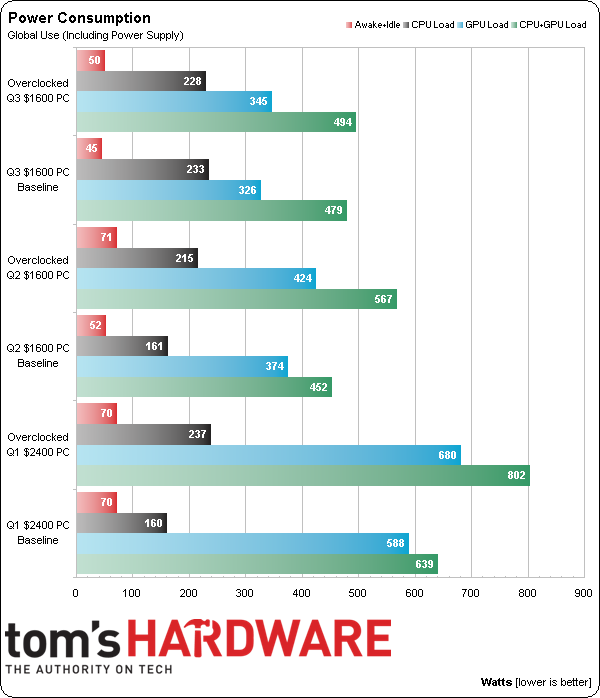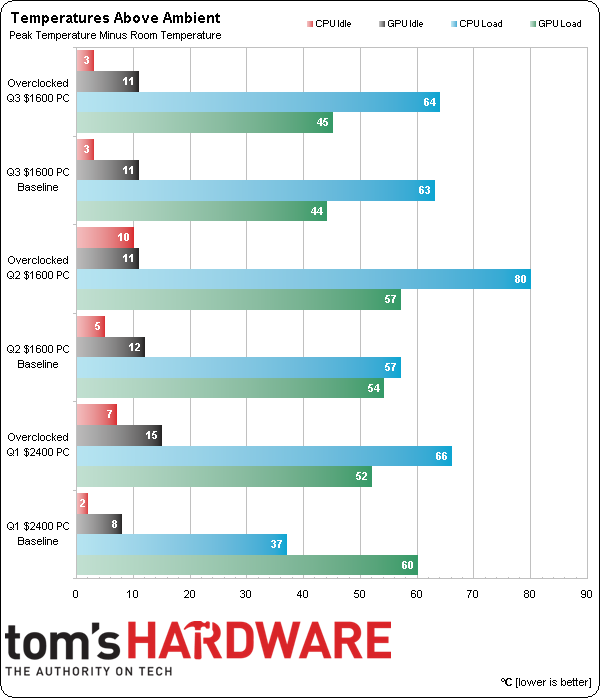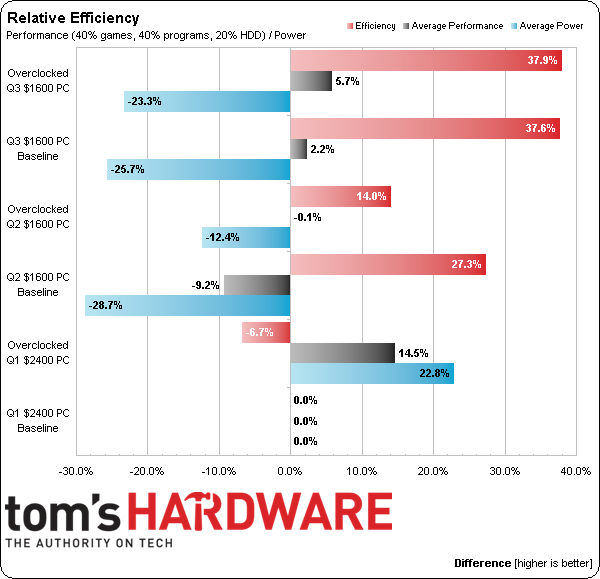System Builder Marathon Q3 2014: High-End Performance PC
Power, Heat And Efficiency
Last quarter's system lagged in memory performance at stock settings, but it was also able to claim the lowest combined-load power consumption.
Meanwhile, the new system needs far less voltage to achieve its best overclock, actually reducing power consumption in our CPU-only test.
Of course, the performance of two graphics cards costs big in terms of power for the $2400 machine. These days, you could use a couple of GeForce GTX 980s and enjoy better performance for similar consumption.
The new PC’s CPU temperature doesn’t rise when it's overclocked, mostly because I was able to reduce the fixed voltage setting compared to the stock slope’s maximum. GPU temperatures are similarly stable, mostly because I was able to leave the card’s fan slope at PowerColor's factory settings.
From a cooling value perspective, I might have gone overkill on the new $1600 PC. It certainly didn’t need a $75 cooler to run at this low overclocked voltage. Conversely, I couldn’t have known how much voltage it would need until after I received the processor! Oh, the real-world issues we face as PC builders.
The new build starts out 2.2% more efficient than Q1’s $2400 machine and 11% better than its second-quarter incarnation. Because it was overclocked at relatively low voltage, its class-leading efficiency improves with the added frequency.
Get Tom's Hardware's best news and in-depth reviews, straight to your inbox.
Current page: Power, Heat And Efficiency
Prev Page Results: File Compression Next Page Is There Such Thing As A Perfect $1600 PC?-
Onus Alternate builds, regardless of other merits, which do not conform to SBM rules (e.g. parts from sources other than Newegg) will be deleted as off-topic to the SBM discussion.Reply
-
SuckRaven I love the SBM articles that Tom's publishes, and read them regularly. However with respect to the self-limiting / self imposed (or perhaps not self) budget constraints, I feel that often the various builds end up feeling somewhat dated. I understand this is a result of the criteria that are set, and well explained, but I also think Tom's should do a somewhat more price-no-object oriented build as well. Of course, I am aware of the difficulties here. But a build with current motherboards with X99 chipsets, the newest Haswell-E processors, the latest in NVIDIA / AMD multi-GPUs, DDR4 RAM, the fastest/most durable SSDs, and liquid and air cooling might be of interest to a lot of readers as well (including myself). Efficiency and performance value/dollar aside, I would love to see a machine like this go head to head with the current high-end build, just for the sake of curiosity, if not necessarily practicality.Reply -
Onus I thoroughly enjoyed the writeup of this PC. I've often found selections in the high-priced build way more than I need myself, but this is the first time I can recall not also thinking "what a waste" about one part or another. This one was good.Reply -
mavikt I won't get excited for a new build until both CPU and GPU have gotten their die shrink.Reply
These quarterly builds usually only show miniscule improvements unless something disruptive happens to the market like a tick or tock. These articles could as well be bi-annual. Good though that the price point that you're at shifts from time to time. -
bmyton 4790k -> 4690k = -$100Reply
290x -> SLI 770 = +$100
Same budget, theoretically a 10-15% performance boost, and new topic of discussion as part of the article.
These SBM builds have taken very few risks in the last few quarters... -
Crashman Reply
I was actually thinking of using two of the cards Don used in his build, before I found out that Don had one. That would only be +$20 without downgrading the CPU.14249729 said:4790k -> 4690k = -$100
290x -> SLI 770 = +$100
Same budget, theoretically a 10-15% performance boost, and new topic of discussion as part of the article.
These SBM builds have taken very few risks in the last few quarters...
-
Mac266 PCPartPicker part list / Price breakdown by merchantReply
CPU: Intel Core i5-4690K 3.5GHz Quad-Core Processor ($239.99 @ Newegg)
CPU Cooler: Cooler Master Hyper 212 EVO 82.9 CFM Sleeve Bearing CPU Cooler ($34.99 @ Newegg)
Motherboard: ASRock Z97 EXTREME4 ATX LGA1150 Motherboard ($143.79 @ Newegg)
Memory: Team Vulcan 8GB (2 x 4GB) DDR3-1600 Memory ($76.99 @ Newegg)
Storage: Crucial MX100 256GB 2.5" Solid State Drive ($115.98 @ Newegg)
Storage: Western Digital Caviar Blue 1TB 3.5" 7200RPM Internal Hard Drive ($59.99 @ Newegg)
Video Card: Asus GeForce GTX 780 3GB DirectCU II Video Card (2-Way SLI) ($329.99 @ Newegg)
Video Card: Asus GeForce GTX 780 3GB DirectCU II Video Card (2-Way SLI) ($329.99 @ Newegg)
Power Supply: Corsair Professional 850W 80+ Gold Certified Semi-Modular ATX Power Supply ($129.99 @ Newegg)
Total: $1461.70
Prices include shipping, taxes, and discounts when availableGenerated by PCPartPicker 2014-09-25 18:14 EDT-0400
What about this? Might be cheating, given the price drops from the GTX 900 series release. Also add $10 from a promo on the PSU. -
DynamoNED This is one of my favorite High-End Builds in recent memory, because it is very balanced, without some of the excesses from previous builds. It's very nearly what I would build myself on that budget. Bravo, Thomas!Reply -
10tacle This is like the third SBM article I've seen that just missed the latest GPU release, and hence, it wasn't included. Surely it was known the GTX 980 release was around the corner when this build was thought up. Is there a reason why these SMBs can't be held off if it is known a new GPU series is coming out (and will actually be available in stock) within a matter of a couple of weeks or even a month?Reply
With that said, I do find these SBM articles most interesting of all.




